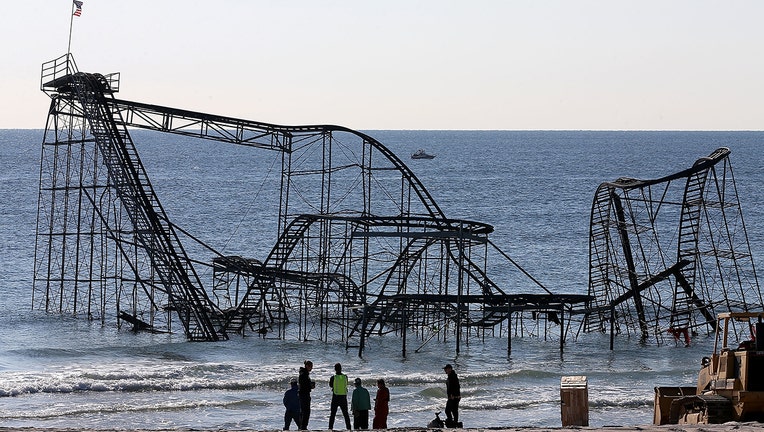
Staff get ready to take out the Star Jet roller coaster that has been in the ocean for six months soon after the Casino Pier is sat on collapsed when Superstorm Sandy hit, May possibly 14, 2013 in Seaside Heights, New Jersey. The Casino Pier has contracted Months Mar
ATLANTIC Town, N.J. – New Jersey will incorporate the impacts of local climate change and soaring seas into all its main plan selections in the near long term, and will find to share the fees of shielding the point out amongst all ranges of authorities and the personal sector.
A report introduced Thursday bluntly predicted “it will be progressively tricky for people today to dwell and get the job done in coastal areas as sea-stage rise inundation raises,” recommending the point out incentivize a go absent from the riskiest spots.
In its very first local weather resiliency method, unveiled on vacant land in Woodbridge where the point out has purchased and demolished several properties in a flood-susceptible region, condition officers fully commited on their own to making confident significant decisions in most regions of federal government are created with weather improve and its risks in thoughts.
And while not putting a value tag on everything, the report acknowledges the apparent: this is likely to be expensive. To raise added dollars for resilience projects, the report lists choices such as borrowing, taxing, imposing focused fees, and selling “environmental influence bonds.”
“We are ground zero for some of the worst impacts of local weather change,” said Shawn LaTourette, the state’s acting environmental protection commissioner. “We have to get ready for what is going on listed here currently in our point out, and what we know is to appear.”
5 Many years Soon after SUPERSTORM SANDY
The report mentioned, “Just about everything the point out spends revenue on will be impacted by weather transform.”
The plan seeks to incentivize folks to shift from flood-susceptible spots to safer kinds, would aid very low-money communities who are the very least capable to respond to the effects of local weather adjust, and seek out new funding for resiliency measures.
The approach also acknowledges what may possibly prove to be an inconvenient reality: the state does not have enough cash and assets to build shore defense initiatives in every susceptible location together the coast.
“For New Jersey to lessen coastal flood danger, all stages of authorities, and personal and nonprofit companies must share resilience expenditures,” the report read through. “As local weather alter will involve an ‘all palms on deck” tactic, so too ought to the economical burden be shared beyond point out governing administration.”
It identified as for prioritizing these kinds of jobs to shield big population and economic centers crucial infrastructure, and socially vulnerable populations.
At the exact time, the state reported it will help the development of regional resiliency plans in just about every coastal municipality by means of assets and technological support.
The report observed that sea concentrations could increase by 1 to 2 feet by 2050, and 2 to 5 feet by the finish of the century, making use of average projections. A 2018 report by the Union of Involved Scientists said that in excess of the up coming 30 many years, at minimum 62,000 New Jersey households are at danger from persistent flooding. Of these similar homes, the report identified, 2,600 had been rebuilt following Superstorm Sandy in 2012.
It located that among 2010 and 2017, above 4,500 new residences, valued at $4.6 billion, had been developed in locations at chance of flooding.
The approach endorses designating “sea-level chance zones” and discouraging development in them.
It also advocated measures that authorities and environmentalists have lengthy agreed are required, which includes incorporating mother nature-based mostly alternatives like wetlands restoration and establishment of oyster reefs as solutions to hardened engineering options like sea partitions and bulkheads exactly where feasible.
Private residence house owners together the coastline who do so, changing a bulkhead with a “residing shoreline,” could be rewarded with tax rebates or credits, the report prompt. Similar tax incentives could be offered to advancement assignments built in considerably less-dangerous regions inland.
Elevating properties in flood-susceptible parts is a extended-term solution only if nearby governments commit to keeping nearby infrastructure and utilities “in perpetuity,” the report browse.
As far back as 1981, New Jersey recognized a will need for systems to encourage relocation from coastal hazard parts. As of February, its Blue Acres software had bought and demolished just about 700 properties in flood-inclined areas.
But none has been in an oceanfront spot, exactly where land is basically way too important to wander absent from.
Jeff Tittel, director of the New Jersey Sierra Club, said the plan it way too obscure.
“The new resilience tactic is actually a tactic to stay clear of bold action,” he reported. “There are no strong steps, it is a system to make a system.”
